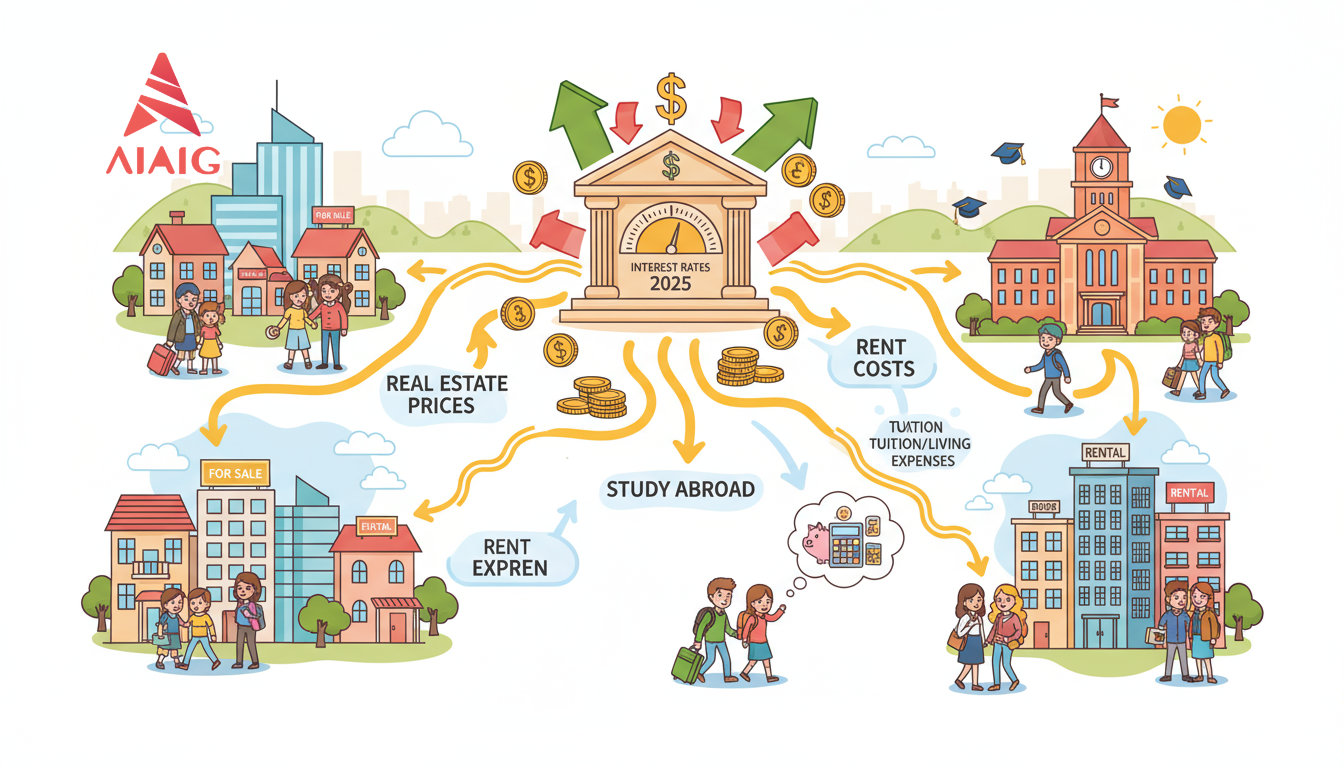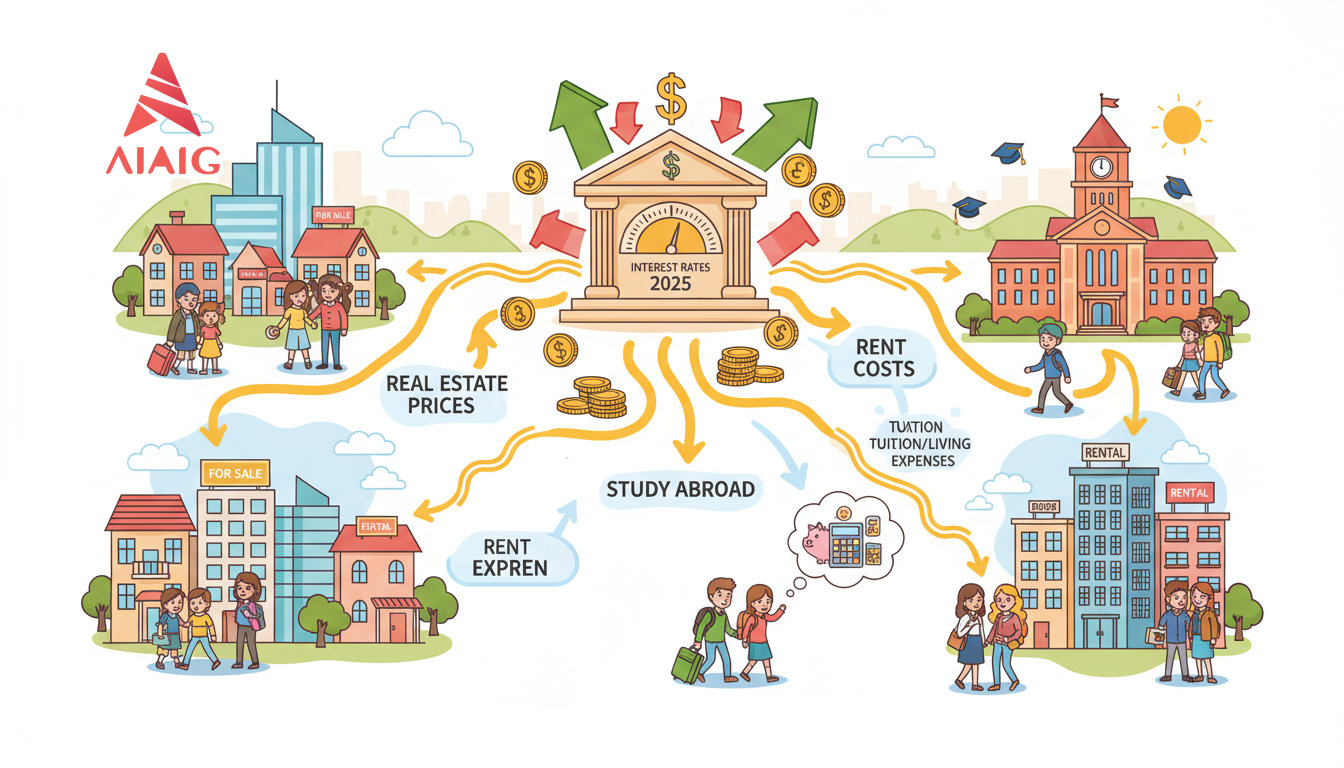2025 Latest Deposit Interest Rates Summary and Discussion (Part 2)
Covers the overview of current and fixed deposit interest rates (in local currencies) for Malaysia, the Philippines, Indonesia, and Cambodia (from early 2025 to present), and systematically analyzes the impact and outlook on real estate, rent, and study abroad costs in the context of macro policies, inflation, and exchange rates.

What is the research scope, timeframe, and methodology of this report?
• Timeframe: Early 2025 to present (based on information up to November 2025).
• Interest Rate Methodology: Focus on local currency denominated demand/savings deposit rates and term deposit rates (primarily 12-month) at listed or mainstream average levels, prioritizing publicly available information from central banks and leading commercial banks for retail deposits.
• Analysis Dimensions: Macro policies (monetary policy, inflation, exchange rates), real estate (prices/transactions/inventory), rents (yields and differentiation), study abroad costs (impact of inflation and exchange rates on living expenses/tuition fees).
What is the overall trend of interest rates and policies in the four Southeast Asian countries in 2025?
- MY: Policy rates remain neutral to accommodative; retail term deposits mostly around ~2%.
- PH: After high inflation, began cutting rates, 1Y term deposits ~4%+, demand deposits about ~1%.
- ID: After multiple rate cuts in 2025, retail term deposits have dropped significantly, 1Y mostly 3%–4%.
- KH: High dollarization, term deposits around 4%–5%, demand deposits low; overall interest rates have declined compared to 2024.
• Macro Policy Stance: Stabilizing prices → creating room for growth stabilization; stable exchange rates are a key constraint for rate cuts.
Why are these changes highly relevant to real estate, rents, and study abroad costs?
• Rents: Depend on supply and demand and employment, with interest rates indirectly influencing through economic and home-buying substitution effects; when short-term supply is ample, rent increases are limited.
• Study Abroad Costs: Driven by inflation and exchange rates; low local inflation and stable exchange rates against major foreign currencies → more controllable living expenses and tuition fees for international students when converted.
🇲🇾 Malaysia (MY): What is the latest trend for current/fixed deposits in 2025?
• Fixed (12M): Approximately 2.0%–2.4% is the common listed range, with some promotional offers slightly higher; overall, it is slightly lower or flat compared to 2024.
• Policy Linkage: In the context of mild inflation and moderate growth, policy interest rates remain neutral to accommodative; retail fixed deposits thus stay in a low range.
🇲🇾 How do Malaysia's macro policies, inflation, and exchange rates affect real estate and rents?
• Housing Prices: Nationwide, overall moderate and divergent; new projects in core urban areas are cautiously launched, with price reductions for volume being more common.
• Rents: Ample supply → National apartment gross rental yield is around 5%, with Kuala Lumpur's core areas having a yield slightly below the national average due to higher base property prices.
🇲🇾 What are the implications of Malaysia for study abroad costs?
• Universities and Rentals: Rent increases are moderate; shared rentals and suburban apartments still offer good value for money.
🇵🇭 Philippines (PH): What is the latest situation for demand/time deposits in 2025?
• Time Deposit (12M): At the beginning of the year around 4.2%, gradually decreasing to ~4%+ during the year due to policy; significantly lower compared to the high inflation period in 2023.
• Policy Pace: After inflation fell near the lower target range, the central bank initiated gradual interest rate cuts, providing room for bank-side interest rates to decline.
🇵🇭 How has Philippine real estate and rent performed during the transition from high to low interest rates?
• Rent and Yield: National residential gross yield ~5%, but regional differentiation is significant: rents in core business districts are more stable, while bargaining power is stronger in supply-concentrated bay areas.
🇵🇭 What insights does the Philippines offer on study abroad costs?
• Tuition: Overall moderate increases, but relatively controllable compared to inflation; total cost in foreign currency budget is roughly the same as the previous year.
🇮🇩 Indonesia (ID): What is the latest situation for demand/time deposits in 2025?
• Time Deposits (12M): After multiple interest rate cuts, mainstream personal time deposits are around 3%–4%; a significant decline compared to 2024.
• Policy Pace: The central bank adopts aggressive easing to stabilize growth, with inflation at the lower end of the target range providing room for rate cuts.
🇮🇩 What are the key observations for the real estate and rental market under Indonesia's easing cycle?
• Stimulus Policies: Housing-related tax cuts/subsidies improve affordability for first-time buyers;
• Rents and Yields: In areas like Jakarta/Bali, gross returns commonly 5%–6%, which are competitive in the region.
🇮🇩 What are the impacts of Indonesia on study abroad costs and foreign residency?
• Accommodation and Living: Rents in core cities stable with slight increases, but with overall mild price levels, students' total monthly expenses remain flat or slightly lower compared to last year.
🇰🇭 Cambodia (KH): What is the latest situation for demand/time deposits in 2025?
• Demand/savings: Generally very low (0%–0.5%).
• Time deposits (12M): Declined compared to 2024 to the ~4%–5% range, with some small and medium institutions offering higher rates to attract deposits.
🇰🇭 How does Cambodia's macro stability framework transmit to real estate and rents?
• Real estate: Moderate recovery driven by tourism and foreign capital inflows, mainly focused on destocking; Phnom Penh and surrounding provinces lead the rise, with apartment clearances and price-for-volume strategies coexisting.
• Rents and yields: Phnom Penh apartments commonly have gross returns of ~7%, attractive in Asia; occupancy rates in high-end/core areas improve faster.
🇰🇭 What is the core assessment of study abroad costs in Cambodia?
• Tuition and accommodation: Low base with limited increases, total cost growth is minimal; second- and third-tier cities offer outstanding cost-effectiveness.
Comparison and Trends of Interest Rates in Four Countries: Who Will Be 'Loose' and Who 'Tight' in 2025?
• Term Deposits (12M) Relative Levels (from high to low, roughly): KH (~4%–5%) ≥ PH (~4%+) > ID (~3%–4%) > MY (~2%–2.4%).
• Trends: Except for MY maintaining low and stable levels, PH/ID have experienced rate cuts → retail term deposits moderately declining; KH follows market conditions as US dollar interest rates peak and fall.
What Are the Key Points of Cross-Country Differences in Real Estate and Rent?
• Rental Yield: Roughly KH ~7% > ID ~5%–6% ≥ PH ~5% ≥ MY ~5% (lower in core areas); but net returns need to be assessed comprehensively considering occupancy rates/taxes/maintenance.
How Does It Comprehensively Affect Study Abroad and Family Budgets?
• KH: Most expenses are in US dollars, low exchange rate risk; overall low base, limited increases → high cost-effectiveness.
For real estate investors: What are the strategic recommendations for 2025?
• Inventory reduction and profit concessions: The price-for-volume phase in PH and MY is a bargaining window; ID may see volume transactions prioritized with price lag in the early stages of interest rate cuts.
• Compliance and taxes: Under KH's high gross returns, specifically calculate taxes, maintenance, and management to achieve net profit; differences in foreign purchase policies require checking the latest terms item by item.
For rental operators: How to allocate across different markets?
• PH: In supply-concentrated areas, achieve higher occupancy rates through differentiated furnishing and services;
• MY: Choose projects with better location/commute/community amenities to improve conversion and renewal rates.
For families with students studying abroad: How to optimize budget and risk?
• Location trade-offs: MY/PH urban clusters offer convenient living and rich international curricula; ID provides improved cost-effectiveness in living expenses and cultural experiences; KH stands out for low base costs and USD pricing stability.
What are the limitations of this report and recommendations for data updates?
• Policy pace may adjust rapidly due to external shocks (energy, food, exchange rates), requiring quarterly review.
• Urban differentiation is significant: real estate and rents should use the city/district as the minimum decision unit, avoiding substitution with national averages.
Quick Checklist (for Investment and Study Abroad Decision-Makers)
2) Target city new property sales rate/vacancy rate/tenant structure;
3) Target school tuition currency/increase mechanism and accommodation location information;
4) Bank actual annualized return (taxes/compound interest/early withdrawal terms).
Next Executable Actions (Optional)
• Establish rental sample tracking by city (listing price, transaction price, vacancy rate), updated monthly.
• Study abroad budget table: simulate 12–24 months of cash flow under inflation and exchange rate scenarios.
